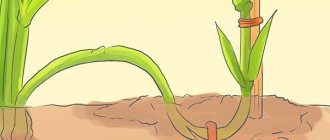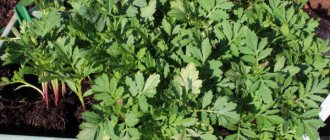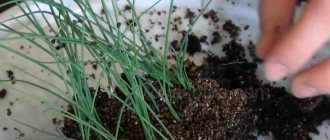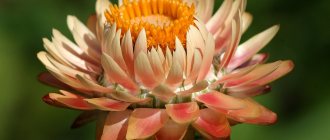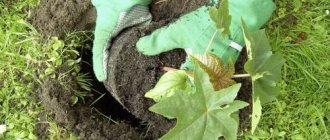Having such an attractive name, the plant attracts attention for a reason. Its chic velvet look delights and fascinates. It stands great both in the flowerbed all season until frost, and as a cut flower for a bouquet. Carnation Shabot belongs to the carnation family, the existence of which has been known since ancient times. Back then, cloves were used not so much for decoration as for flavoring, enhancing the taste of dishes and healing. Breeders from wild species have created a huge number of species and varieties that differ in color, size, shape and stress resistance to weather conditions.
The hybrid species, Shabot carnation, is a plant with a long growing season before flowering, so seedlings are prepared long before the start of the summer season. The plant is fastidious in care, but has its charm. Double and semi-double flowers on long stems, linear bluish-green leaves collected at the base of the bush, a wide variety of colors. There are monochromatic representatives and mixed ones, where the color goes from dark to light or combines several different tones of the same range.
Description and features of Shabo cloves
In European countries, Garden Shabo is considered a modification of the Dutch carnation, but in our country it is known as an independent plant. The first time we learned about it was in France. They named it after the pharmacist, thanks to whom it appeared. This is a small bush 40-60 cm, with gnarled stems with a pale tint. They grow leaves of a protective color and large flowers with a delicate scent. Fluffy varieties are distinguished by fantastically shaped petals, corrugated and cut at the edges. The most varied colors: red, yellow, pinkish, coral, white, purple. Graceful and fragrant flowers are the best for cutting. Look great in bouquets.
The main quality is the ability to bloom repeatedly: all summer and autumn until the first frost. The formation of buds in the southern regions is observed throughout the year. You can admire the flower for 5-10 days. If the weather is hot and dry, the petals instantly fade and lose their charm. Flowers that are pink and scarlet in color are the hardest to bear. Seeds are formed 2-2.5 months after the start of blooming. The fruit looks like an elongated box, which has a thin corner at one end. Opens up quickly. Each bush can produce 2.5 grams of seeds, which remain suitable for planting for 3-4 years.
In Russia it grows as an annual plant. It can overwinter in the soil if it is well covered.
Shabo carnation varieties
Some familiar and beautiful varieties.
| Variety | Flowers |
| Legien D'Honaire | Dark cherry red. |
| Marie Chabot | Bright lemon. |
| Mont Blanc | Smelly white. |
| La France | Soft pink. |
| Girofle | Interesting purple ones. |
| Ruby | Fiery. |
| Zhanna Dionysus | Large snow-white ones. |
| Mikado | Lilac. |
| Champagne | A little golden. |
| Nero | Velvet red and black, do not fade in the sun. |
| Fire King | Bright orange. |
Today, a large number of new species have been developed. They have not yet gained such popularity as the old, classic ones.
Growing Shabot cloves from seeds
This flower, familiar to everyone, is bred from purchased seeds. They are quite affordable and easy to purchase. Usually 500 sprouts grow from one gram. The germination rate is 80-95% and lasts for 2-3 years, so seeds are purchased in advance. It is quite difficult to collect them on your own. For ripening, warm, cloudless weather and no precipitation must persist for a long time. The duration of this period is 1.5-2 months. To collect all the seeds, the fruits are wrapped in light material and observed. When ripe, they instantly fall off.
In areas with cold autumn, to obtain seeds, flowers are transferred to places where suitable conditions can be provided.
Landing Features
Chabot carnation is a perennial plant that is primarily grown in an annual cycle and does not survive severe frosts. Due to the long growing season until the flowers bloom, the seedling method is used, expecting to get the first flowering 5–6 months after sowing. To enjoy the luxurious flowers of Shabot in early July, sowing is carried out in January.
Seed propagation
Although clove seeds are suitable for sowing for 2–3 years, over time their quality rapidly deteriorates and it is better to use fresh seeds. According to the observations of flower growers, on average, it takes three seeds to produce one sprout.
For sowing, prepare a loose nutritious soil mixture from humus, turf soil, and high peat in equal parts, adding half a part of sand. The prepared mixture is disinfected by steaming, heating in the oven, or spilled with fungicide solutions, for example, the drug Maxim. A good option is to use ready-made purchased substrates for growing flower seedlings.
Before sowing, untreated seeds must be pickled in a solution of one of the fungicides (Fundazol, Maxim, Fitosporin-M). Sowing is done in furrows every 5 cm, lightly pressing the seeds into the soil. The surface is moistened by spraying, sprinkled with clean sand or peat to a height of 0.3–0.5 cm and covered with film. Place the boxes in a warm place at a temperature of 16–18°C; sprouts will appear in 5–6 days.
After the mass emergence of seedlings, the film is removed, the seedlings are transferred to a bright window, lowering the temperature to 12–14°C for at least a week. Without this technique, the seedlings will turn out weak and elongated. Watering is carried out moderately, young plants are given additional light from January to early March.
At the moment a pair of true leaves appears, the seedlings dive into cups with fresh nutrient mixture. The second picking is carried out when there are four pairs of leaves; when the fifth pair appears, the main stem is pinched.
With the onset of spring warmth, the seedlings are hardened off and, if possible, transferred to greenhouses or hothouses, making sure that the temperature at night does not fall below 8–10°C, providing regular ventilation and good lighting.
Vegetative propagation
In the fall, your favorite carnation bush can be planted in a pot and brought into a bright veranda. In this case, it will bloom until December, and even longer at temperatures of 15–17°C. In October cuttings with an apical bud can be cut, treated with a root formation stimulator, kept in a fungicide solution and placed in a box with a nutrient mixture every 8–10 cm.
After planting, the soil is compacted, watered, sprinkled with peat and covered with film, forming a kind of greenhouse. To maintain foliage turgor, the cuttings are regularly sprayed, not forgetting to ventilate from time to time, and watered in moderation.
For young plants developing from cuttings, a temperature of 10–12°C is sufficient. Rooted cuttings are planted in pots with a diameter of 7–8 cm and transplanted to a permanent place in the spring. With proper care, they bloom early, for a long time, abundantly and, most importantly, completely retaining the characteristics of the mother plant.
Reproduction of Shabot carnations by layering is rarely used, and only with a multi-year growing cycle, which is available only in the southern regions.
If desired, you can use the method of dividing a bush , for which a large plant is dug up in the fall and divided into several parts with a developed root system and strong shoots. Peduncles are removed, vegetative shoots that are too long are trimmed, and the resulting bushes are planted in pots and brought indoors for the winter. In spring they are planted in flower beds in the usual way.
Seedlings are planted in April-May, covered with light agrofibre when there is a threat of frost. Well-rooted bushes easily tolerate low temperatures. When planting, try not to deepen the rosette too much; water and add a layer of mulch.
Sowing Shabo cloves
The time when it is necessary to plant seeds for seedlings is determined from the beginning of flowering in the summer. Therefore, Shabot is planted from January 10 to February 28. At earlier times, seedlings are not sown. To grow it, you will need special equipment, which is most often not available. Before planting, you need to prepare: sand is fried for covering, the seeds are not treated, but sometimes they are moistened with some diluted growth stimulant, the soil is not sifted. The prepared dishes are filled with soil, leveled, and watered. They use a light base, for which they take two parts of turf (garden) soil, manure, peat and one part of sand. The height of the container should be 5-6 cm and have drain holes. Using tools, depressions of 0.3 cm are formed with a distance of 3 cm between them. Each seed is laid out separately in a 1 cm piece, covered with sand and covered with glass or a special film. Condensation may form. It must be removed.
How to propagate Shabot carnation from cuttings
How to cut carnation Shabot photo
Shabot carnation cuttings are a common propagation method. For this:
- Cut cuttings 5 cm or more long.
- Remove the lower leaves.
- Keep in a solution of heteroauxin or root according to the instructions.
- Planted in prepared containers with soil for flowering plants.
Propagation of carnation Shabot by cuttings
- Moisten the substrate and cover the containers with cling film, a plastic container or glass to create greenhouse conditions.
- Ventilation is carried out daily.
- When the first shoots appear, they begin to harden the seedlings, arranging air baths without shelter, gradually increasing the time.
- When the plants get used to it, the film or glass can be removed.
Ready seedlings can be planted in the garden in established warm weather without frost. Such plants will bloom much earlier than those grown from seeds.
Video about cuttings of Shabot carnation:
Caring for Shabo carnation seedlings
Caring for seedlings is quite difficult: it is necessary to provide pleasant humidity and pinch them in due time. In addition, be sure to do the following:
- constantly maintain the temperature +12…+15 °C;
- create the best lighting, and turn on additional lighting for several hours;
- provide ventilation in warm weather;
- pinch the tops when the fifth pair of leaves forms to enhance branching;
- prevent excessive moisture, water only to maintain humidity;
- carry out foliar feeding with saltpeter.
Plants with signs of disease (black leg, weakening) may appear. It is best to remove such seedlings and treat the soil with a mixture (sand, ash and crushed coal).
Picking and hardening of Shabot carnation seedlings
The clove must be pricked twice:
- For the first time, a pair of whole leaves has formed. Transplant into a container with a diameter of approximately 4 cm.
- Secondary - at the very end of March, when 4 pairs of leaves are formed. Pots are used with a diameter of about 10 cm.
The height of the recess does not change. If the plants have grown a lot, you can increase it by 2 cm. After the fifth leaf appears, you need to pinch it. In case of slow growth or pale color, light feeding is done. Hardening begins after all picks. Carry out using various options:
- Place overnight in a cold room, the temperature in which should be 10 °C lower.
- In warm weather, greenhouses can be used. Only if frosts are not expected at night.
- It is allowed to be moved to an open place during the daytime, which must be protected from the wind. In the dark they return back.
Picking seedlings of perennial carnation Shabo
This process is aimed at strengthening the root system. It allows the root system to become more branched. It is necessary to carry out two picks.
The first picking should be carried out during the formation of the first 2 pairs of leaves. At this stage, young seedlings must be transplanted into separate spacious containers. The distance between seedlings should be at least 4 cm.
The second picking is carried out when the seedlings have 4 pairs of leaves. Seedlings are transplanted into even wider containers. With each picking, it is important not to increase the level of deepening of the root system.
Planting Shabot carnations in the ground
Planting in open ground is almost always the first days of May. Hardened seedlings do not require special heat, and they are not afraid of a short cold temperature of -3 ° C. It is advisable to choose neutral or slightly alkaline soil. There should be a lot of sun on the site. It will not be able to grow if sandstone or clay is used for planting. The soil is prepared in advance, in the fall: they dig it up, add 45 g of phosphate, 20 kg of compost or manure per m2. In spring, fertilizers are used that contain nitrogen (15 g) and potassium (25 g) per m2. The seedlings are well moistened, then carefully removed along with a lump of earth and moved into the prepared recesses. The root system is left at the same level. Plants are placed at the rate of 16 pcs. per m2.
After planting, be sure to thoroughly water.
Description
Garden carnation Shabo can be perennial or biennial. Externally, the flower is a dense bush with small gray-blue leaves. The color of the buds depends on the type of carnation and can have any shade.
The height of the bushes can reach 60 cm. The diameter of the buds is up to 6 cm. For full growth of the plant, a warm and well-lit area is required. The flower has a long flowering period.
When does carnation bloom? Plant development continues for up to six months. Carnations begin to bloom in July and continue flowering until frost. The plant can overwinter in open ground only in warm climates. If you prepare the bushes for wintering, then it can bring a winter typical for central Russia.
You can grow cloves:
- in the flowerbed;
- on any suitable garden plot;
- in pots on the windows.
The natural habitat of flowers is Mediterranean countries. There are more than 300 varieties of this plant.
Varieties
There are many varieties of carnations, differing in the color of the buds and the size of the bush. The most popular varieties are:
- Pikoti Dionysus. A bush reaching a height of 60 cm can contain up to 30 buds with a diameter of 5-6 cm. The flowers have a white or light pink hue and a strong aroma. Cut buds can stand in a vase for a long time.
- Pikoti fairy tale. The buds can have a diameter of up to 7 cm. The color of the flowers is white or pink with a bright purple or pink edging. The height of the bush is 50 cm; one plant can have up to 5 inflorescences.
- Lyon. The buds are yellow or lilac in color. The diameter of the flowers can reach 4 cm. The plant can withstand light frosts down to – 10 degrees.
- Watercolor. Bushes can be from 30 to 50 cm in height. The color of the buds is very diverse. The aroma of flowers is persistent and pronounced.
- Disco. One flower on a carnation can be 8 cm in diameter. The plant is suitable for forming bouquets and growing in open ground.
- Maria Shabo. The oldest plant variety with flowers 8 cm in diameter.
Care for all plant varieties is the same.
Caring for Shabot carnations
To get a beautiful flower you will need to spend a lot of effort. Caring for it requires the following actions:
- regular watering to maintain slight dampness;
- gentle weeding and loosening;
- adding fertilizers to the soil: first nitrogen (15 g per m2), a week after planting when the ovary appears - ammonium nitrate and potassium sulfate (10-15 g per m2);
- not using biological additives;
- securing tall plants to prevent them from breaking;
- constant monitoring of appearance;
- carry out preventive measures to protect against diseases and pests.
Planting in the same area for more than 2 years is not recommended. Frequent planting should not be done. To obtain powerful flowers, it is necessary to take stepson, breaking out the entire ovary and branches up to 6 nodes, leaving only the central bud. Timely removal of dried buds will increase the flowering time. In cold autumn, development activity decreases, and the opening of buds continues at a slow pace.
Planting perennial carnation Shabo in a flowerbed
It is necessary to harden the carnation seedlings before planting them, and then in the spring you can plant them in the garden; the flowers can withstand frosts down to -3 degrees.
This crop is unpretentious, and it can be planted in a flowerbed even when it is already blooming. If the transplant is done carefully, the flowers will quickly take root and continue to bloom.
The soil for transplanting carnation seedlings needs to be prepared in the fall. To do this, the area is first dug up and fertilized. For one square meter of flower bed, add 20 kg of humus or compost and 40 g of phosphates. In the spring, an additional 25 g of potassium fertilizer and 15 g of nitrogen fertilizer are added.
Scheme for planting Shabot carnation seedlings: 25x30-40 cm, where 30 or 40 cm is the distance between the rows.
The bushes are lowered into pre-prepared holes along with a lump of earth, then they are sprinkled with earth and watered thoroughly.
Pests and diseases
Proper and timely care for Shabot will prevent the development of various diseases or they will only strike occasionally. If the weather is rainy, fungus may appear. The affected plants are then removed, the rest are treated with solutions containing copper.
They are damaged by insects that feed on the sap: aphids, mites, thrips. Characteristic signs: developmental delay, modification, appearance - unattractive. These pests can bring viral diseases. To save plants with a small number of parasites, they are sprayed with an infusion, for which they take onion scales or garlic cloves. You can prepare a solution from soap that contains no more than 72% fatty acids, or 8-10% birch tar. Insectoacaricides (Aktellika, Aktar, Karbofos) are diluted and sprayed with them if the number of insects has increased.
Transplanting seedlings
Transferring seedlings to permanent pots with which you plan to decorate the garden plot can be done with the onset of constant warm weather - at the end of April or in the first days of May. In this case, the plant is first taken out into the open air for the whole day, returning it back indoors at night. This procedure is carried out until the night air temperature outside stops at 8-10 degrees Celsius. A hardened plant can be transferred to open soil as early as the end of May. It is not afraid of even short-term night frosts.
Carnation Shabot prefers well-lit areas of fertile soil. Either neutral or slightly alkaline soil is acceptable, strictly without any admixture of manure. The only acceptable organic fertilizer is mature compost. Also, the soil should not contain clay admixtures. To organize a summer flower bed of carnations, you should carefully prepare the soil in which they will be planted. Starting in the fall, it is necessary to add compost and phosphorus fertilizers to the soil in large quantities. In the spring, soil preparation does not end - a month before transplanting the seedlings, potassium and nitrogen fertilizers are added to it.
Carnation Shabo at home
Chabot is a garden plant that usually does not grow indoors. It can be planted in some container in the fall and moved indoors. By observing the same conditions as when growing seedlings (good light, cool conditions), Chabot will delight with its flowering for some time. Cloves preserved in this way are used in the spring to prepare cuttings.
In indoor climates, it is better to give preference to varieties such as Chinese, hybrid or Turkish carnations.
Hardening of seedlings
They begin to harden the Shabot carnation long before the time for planting it in a permanent place approaches. This plant must begin to adapt to cold weather immediately after the second transplant. The most popular way is to lower the night temperature to 10 degrees Celsius, taking the cloves into a cool room, and on warm days place them outdoors, on a terrace or balcony. With the onset of warm weather, and provided there are no night frosts, the seedlings can be transferred to a greenhouse under a film, which is ventilated during the day and closed at night, or taken to a regular greenhouse.
Hardening plays a role not only in enhancing cold resistance: it is necessary for the health of young plants and the prevention of many problems that arise after exposure to the open air.
Vegetative propagation of carnation Shabo
Reproduction of a hybrid by seeds is far from perfect. Plants obtained in this way may differ in color and lose their fullness. Therefore, to reproduce rare varieties, an alternative vegetative option is used.
In the fall, a bush selected for propagation is placed in a pot and taken into the house. Choose a place that is well lit and not very warm +10...+12 °C. In the spring, cuttings of 3-4 internodes are cut from the plant, placed in water for rooting or in sand, having previously been calcined and moistened. After 1-1.5 months, roots appear, and at the beginning of summer they are planted in the garden.
If you plant and carry out proper care as expected, the buds will appear within this year. Some gardeners cut and root cuttings in the fall and grow them indoors in winter. This is a complex method that requires a lot of effort and expense, so it is used very rarely.
Is it possible to keep Shabot carnations at home in winter?
Particularly valuable varieties of Shabot carnations can be dug up in the fall and transplanted into pots in order to keep them at home in winter. To do this, bushes with a lump of earth are dug up and carefully moved into a pot, trying not to disturb the integrity of the earthen lump.
The planted Shabot carnation is cut to a third of its height and watered with a small amount of water. Gradually, the bushes are watered less and less, and the temperature is reduced (by placing it, for example, on a loggia, and when it is completely cold, the pot is moved to the northern window sill).
Around mid-February, the flowers are placed in a warm, well-lit place and begin to be watered abundantly. It is also important to feed with fertilizer for flowering plants to stimulate the growth of shoots and the formation of flower buds. The regrown axillary shoots are used for cuttings of Shabot carnations.
The mother plant is freed from dried old shoots (they need to be carefully cut off) and planted back in the garden in the spring.
Mr. Summer Resident recommends: new Shabot carnation hybrids
In addition to old, well-known varieties, new ones are being developed. Quite familiar ones include: Pikoti, Watercolor, Disco, Giant Terry and Lyon. They are distinguished by a decrease in the time between the appearance of the first shoots and the beginning of flowering. You can plant the seeds much later, without the need for additional lighting. These varieties are still poorly studied, so breeding is recommended for professionals.
Varieties Luminet mixed (high) and Night Series (low) bloom for almost 7 months, 35 flowers appear on one bush. Compact hybrids can be used to decorate balconies and flower beds. Varieties have appeared that can be grown indoors. When choosing a flower to plant at your first acquaintance, it is better to give preference to the classics and choose only the color of the bud, because the conditions for caring for them are approximately the same. Experienced gardeners can experiment with new hybrids and varieties.
